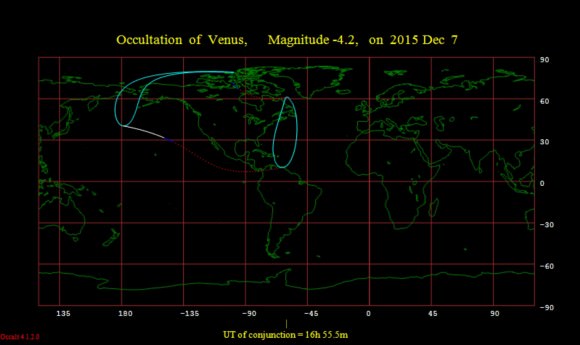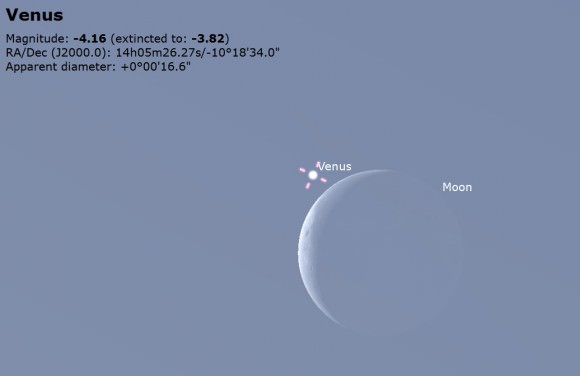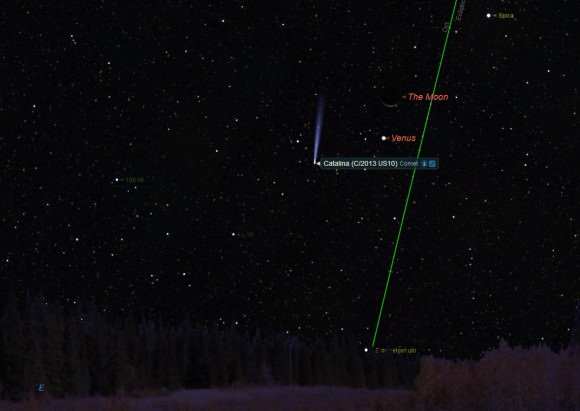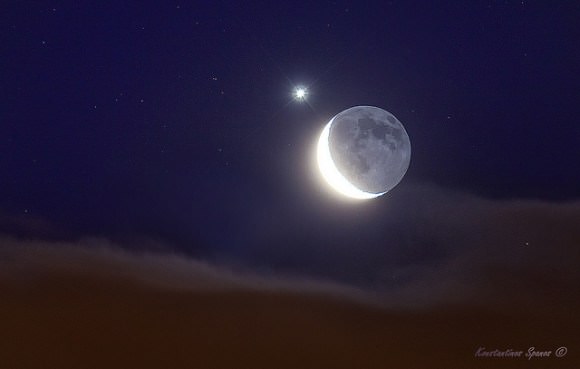The year 2015 saved one of the best astronomical events for last, as the waning crescent Moon occults (passes in front of) the planet Venus as seen from North America on Monday, December 7th.
This is the final of seven naked eye occultations of planets by the Moon in 2015, three of which involve Venus. It’s also the best of the year, well positioned for North America. The event will transpire in daytime skies for a majority of the continent, but don’t despair; Venus is easily visible to the unaided eye near the limb of the daytime Moon. Lucky residents in southern Alaska will get to see the event occur under twilight dawn skies before sunrise, while western North America will have a favorable view after sunrise, with the Moon and Venus high in the sky. Eastern North America will have the toughest challenge, with the pair sandwiched between the high noonday Sun and the western horizon.
On the morning of December 7th, the Moon is a 13% illuminated waning crescent and just four days from New. Venus shines at magnitude -4.2, is 69% illuminated, and 16” in size. The event occurs 42 degrees west of the Sun, and Venus will ingress along the Moon’s daytime side and emerge along its dark nighttime limb.

The International Occultation and Timing Association (IOTA) maintains a great page including event times for northwestern North America. Here’s a selection of events for daytime sites:
Los Angeles, CA: (Moon elevation 44 degrees)
Ingress: 8:06 PST
Egress: 9:54 PST
Salt Lake City, UT (Moon elevation 39 degrees)
Ingress: 9:19 MST
Egress: 10:55 MST
Winnipeg, Canada (Moon elevation 27 degrees)
Ingress: 10:58 CST
Egress: 11:57 CST
Dallas, TX (Moon elevation 41 degrees)
Ingress: 11:05 AM CST
Egress: 12:42 PM CST
Toronto, Canada (Moon elevation 20 degrees)
Ingress: 12:31 PM EST
Egress: 1:35 PM EST
Miami, FL (Moon elevation 27 degrees)
Ingress: 12:54 PM EST
Egress: 2:15 PM EST
Boston, MA (Moon elevation 14 degrees)
Ingress: 12:45 PM EST
Egress: 1:44 PM EST
Note: Moon the elevation value quoted is for the start (ingress) of each event.

Unfortunately, the gibbous phase of Venus means we probably won’t get a chance to replicate the hunt for the elusive and spurious ‘ashen light of Venus’ watched for by David and Joan Dunham from the Australian Outback earlier this year on October 8th, as Venus emerged from behind the dark limb of the Moon:
The planet Venus is surprisingly bright against the blue daytime sky, and its cloud tops present a much higher albedo at 90%. This is the highest of any planet in the solar system, compared to the Moon’s paltry average albedo of 13%. We easily managed to catch Venus near the daytime Moon low to the horizon during an occultation seen from northern Maine on June 18th, 2007.
Reports of Venus in the daytime are also legend… one medieval UFO report of a ‘star’ burning near the daytime crescent Moon spied on June 13th, 1589 by residents of the French village of Saint-Denis was actually the planet Venus. You can wonder just who might have spotted the silvery daytime ember first, and how fear spread through the village, at least enough that someone thought to chronicle the curious sighting…
Westward across the international dateline on morning of December 8th, skywatchers in Australia and the Far East we be treated to a close pairing of the crescent Moon and Venus reminiscent of the Islamic crescent and star symbol that graces many national flags. Watch for Earthshine on the dark side of the Moon, the double reflection of sunlight of the gibbous Earth coming back for one more pass.
But wait, there’s more: Comet C/2013 US10 Catalina shines around magnitude +5.5 just 5 degrees from the Moon-Venus pair on the mornings of the 7th and 8th. If you haven’t seen this binocular comet yet, early next week is a great time to try.

The Moon sits just 0.0027 AU or 1.25 light seconds away on the morning of December 7th, while Venus is 1.004 AU (8+ light minutes) and Comet US10 Catalina is currently 1.41 AU and just under 12 light minutes distant. Watch that comet, as it is headed northward and will put on its best show in early 2016.

And speaking of 2016, we are indeed hammering away like Santa’s elves at our annual ‘Top 101 Astronomical Events for 2016’ post; expect it out on the buffer week between Christmas and New Years Day. Thanks to all who’ve inquired, we always like to refer to it as the ‘blog post it takes us six months to write!’


How long [a few seconds] does it take for Venus to transit the lunar limb? As opposed to instant on-off blinking of occulted stars, it would have been an observational clue to early skywatchers that Venus [and Jupiter, less so with smaller angular size Mars and Saturn] were fundamentally different from stars. I had the amazing opportunity in Greece not long ago to observe Venus rising behind a distant rocky hill, and was able to move around to run the occultation from full to zero, repeatedly, which determined the angular size with amazing precision with naked eye only.
Interesting idea; planets do ‘fade in and out’ during occultations as opposed to stars, due to their tiny angular diameters. It’s possible, would be interesting to know if there was historical records of this.
“just four days from Full.” You probably meant to write “just four days from New.” Full moon is Christmas day; New moon is December 11.
Yup. Good catch.
Shame it will not be seen from Israel
I’ve seen some in the past from 2007! Here is mya rticle and Video of it
My article about previous Venus’s occultation (Together with Tom Rosenfeld)
http://www.thevenustransit.com/2011/10/venus-occulation.html
Waiting for Venus to come back. 🙂 Been watching with an 8″ scope but no camera sadly. I’m in Ventura Co., Ca. Thin high clouds and jet contrail mucking up the sky.
Thanks… let us know how it goes!